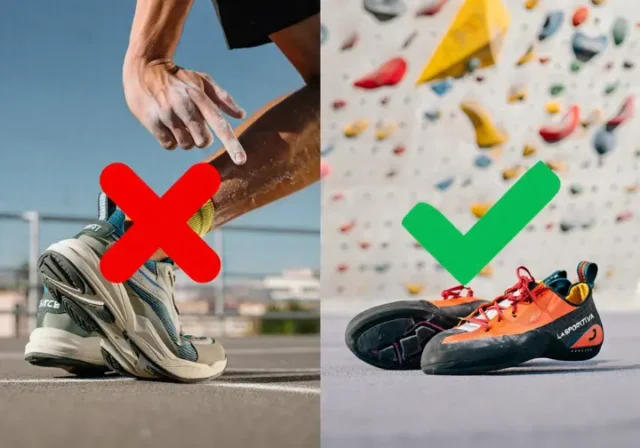In this article
If you’re searching for “rock climbing sneakers,” you’re likely taking your first exciting steps into the vertical world of climbing. This guide is here to clarify why your everyday athletic footwear won’t cut it on the rock and, more importantly, to help you understand the specialized climbing shoes that will keep you safe and performing your best. We’ll explore the critical differences between sneakers and actual climbing shoes, why the right shoe is essential, and how to select your first pair. We’ll also offer some expert recommendations for beginner-friendly climbing shoes that will truly elevate your climbing adventures. Many climbers find that the right climbing shoe makes all the difference.
Why Your Athletic Sneakers Belong on the Sidelines
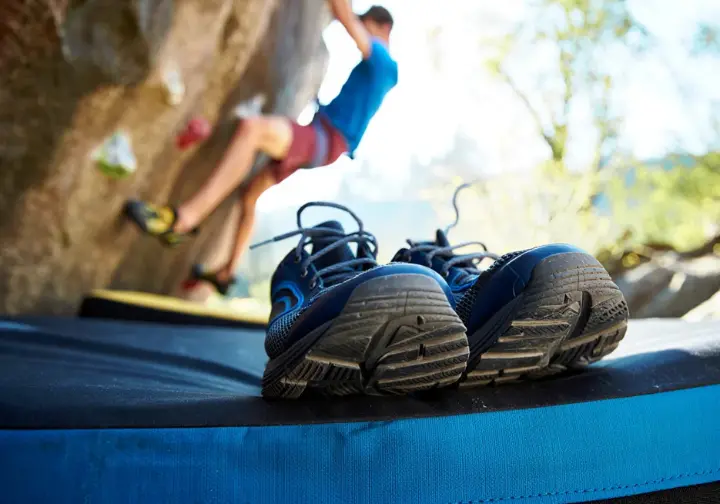
This section dives deep into the reasons everyday sneakers, trainers, or running shoes are fundamentally ill-suited for rock climbing, highlighting performance limitations and safety risks. We’ll clarify why the term “rock climbing sneakers” can be misleading for beginner climbers and explain why authentic rock climbing shoes are the only way to go. Your current shoes might be comfortable for walking, but climbing demands much more.
Friction Failure: The Science of Grip
Specialized climbing shoes feature meticulously engineered “sticky” rubber compounds designed for maximum friction on rock and artificial holds, a stark contrast to typical sneaker soles. This high-friction rubber allows climbers to trust their feet on minuscule or sloping features, even small footholds, that would be impossible with other footwear. Sneaker soles, conversely, are typically made from harder, more durable rubber optimized for longevity on abrasive surfaces like pavement or for specific traction patterns in sports like basketball or trail running. This rubber offers significantly less grip on smooth rock surfaces.
The tread patterns on most sneakers, including prominent lugs and grooves, are designed for traction on loose earth, grass, or for channeling water. On rock holds, these treads actively reduce the surface area contact, minimizing the effective frictional grip and making them inherently slippery. Climbing shoe soles, including the sole of the foot contact area, are often smooth or have minimal texturing to maximize the contact patch of sticky rubber with the hold, similar to how a racing slick tire maximizes contact with asphalt for ultimate grip. This design philosophy is opposite to that of most athletic shoes.
The difference in frictional capability directly impacts a climber’s ability to adhere to the wall, maintain balance, and execute moves confidently. Using sneakers results in frequent slips and an inability to utilize many types of footholds effectively, leading to frustration and a higher risk of falls. For those interested in understanding rubber friction properties, the science is quite fascinating. You can learn more about the science of sticky rubber from outdoor retailers like REI. Understanding the differences in shoe sole design is key to appreciating why climbing shoes are specialized. Further insights on maximising rubber to rock contact can be found in community discussions. For a deeper dive into shoe specifics, finding the right climbing shoe fit is a great next step, as is learning about how a climbing shoe enhances control.
Edging and Smearing Incompetence
Edging involves concentrating weight on small, defined rock features or tiny footholds. Climbing shoes, with their relatively stiff soles and well-defined edges, provide the structural integrity for this, supporting the foot and enabling precise force application. Sneakers, being generally flexible and lacking torsional rigidity, fail at edging. Their soles tend to buckle or roll off small holds, and their bulky, rounded toe box areas lack the necessary precision.
Smearing relies on pressing a large area of the shoe’s sole flat against sloping rock, maximizing sticky rubber contact for friction. While some climbing shoes, particularly a soft climbing shoe, can be flexible, the critical factor is the high-friction rubber. Sneakers fail at smearing due to their non-sticky rubber and thick, cushioned midsoles that prevent intimate rock contact and feel for the foot. This isolates the foot, hindering the ability to generate sufficient grip on featureless rock or granite slabs.
Edging and smearing are foundational climbing skills, not just advanced techniques. Sneakers make learning and correctly executing these fundamental movements virtually impossible, hindering skill development from the start, especially when learning to trust moderate-sized footholds. Exploring foundational climbing footwork techniques can provide a good overview. For more specific skills, resources on mastering edging techniques and the importance of smearing in climbing are invaluable. Improving these skills is part of mastering movement and footwork, which is crucial when understanding basic climbing movements.
The Deficit in Support, Power, and Fit
Climbing shoes are designed for a snug, “second skin” shoe fit with minimal dead space, ensuring efficient power transfer from the leg and foot to the rock. This precision maximizes control and power on small footholds. Sneakers, designed for walking or running comfort, have a roomy fit that allows significant foot movement, including toe movement, within the shoe during climbing attempts. This leads to substantial power loss and a lack of precise control.
The structure of a climbing shoe (last, midsole, rand) is engineered to support the foot in unique ways demanded by climbing, such as maintaining a crimped toe or concentrating force on the big toe. Sneakers lack these specialized support structures. A snug climbing shoe enhances proprioception, allowing the climber to feel rock texture, hold contours, and pressure shifts, which is crucial for micro-adjustments and balance. The arch of the foot also benefits from this specialized support. Sneakers, with thick cushioning and loose fits, numb this vital sensory feedback, making it nearly impossible to develop the nuanced foot-rock interaction essential for skilled climbing. The bulky shape of sneakers can also obstruct the view of foot placements.
For insights on achieving a precise shoe fit and to understand how shoe construction supports feet, dedicated resources are available. The general importance of foot support in climbing cannot be overstated. You can learn how a climbing shoe should fit like a second skin and how fit impacts power transfer.
The Unacceptable Safety Risks
The combined deficiencies of sneakers—poor grip, inability to edge or smear, and imprecise shoe fit—dramatically increase the likelihood of foot slips. A slip, especially on small or precarious holds, can easily lead to a fall and potential injuries. Beyond fall risks, sneakers offer minimal protection against abrasion from rock surfaces. Attempting climbing movements in footwear not designed for such stresses can lead to acute injuries like ankle sprains or ligament strains due to unnatural loading and lack of support.
Even if major trauma is avoided, improper biomechanics forced by inadequate footwear like sneakers can contribute to chronic overuse injuries such as plantar fasciitis or tendonitis. The lack of adequate foot support can force climbers into awkward body positions to maintain wall contact, increasing the risk of musculoskeletal injuries even without a fall. Proper climbing shoes are designed to support climbing biomechanics, reducing these risks, though poorly fitted climbing shoes (even high-quality shoes) can also cause issues. The fundamental design of sneakers, however, makes them inherently unsafe for climbing.
Understanding common foot injuries in climbing and the biomechanics of climbing injuries can highlight these risks. For further reading, understanding climbing related foot problems is beneficial. Adhering to essential safety rules in rock climbing includes using appropriate gear, which is key when you learn mitigating risks when you learn how to rock climb.
Deconstructing the Climbing Shoe: Anatomy of a Performance Tool
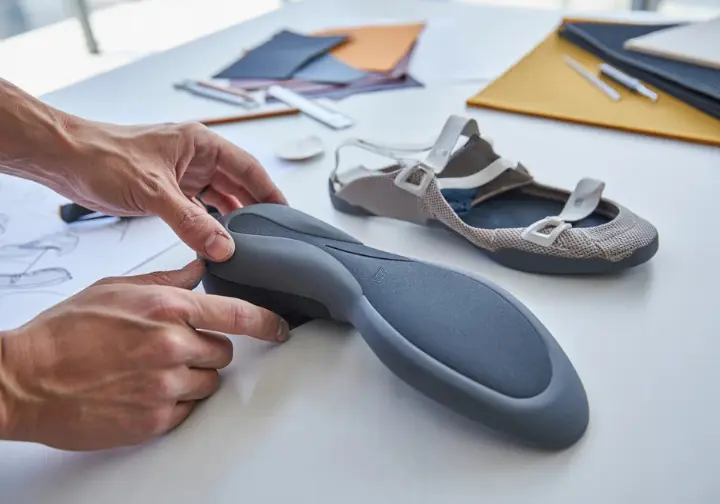
To truly understand why specialized footwear is essential, we’ll break down the key components of a rock climbing shoe and how each part contributes to shoe performance and safety on the rock. This knowledge will help you move beyond thinking about “rock climbing sneakers” and appreciate the engineering involved in every climbing shoe.
The Sole: Your Connection to Rock
The sole of a climbing shoe is made from specialized “sticky” rubber compounds engineered for high friction, allowing adherence to tiny or sloping features. This contrasts sharply with sneaker rubber, designed for durability or general traction. Climbing shoe manufacturers develop proprietary rubber blends (e.g., Vibram XS Grip/Edge, La Sportiva FriXion RS with Grip2 technology), each balancing stickiness, durability, and sensitivity. Softer rubbers offer better grip and sensitivity, ideal for smearing, but wear faster; stiffer rubbers excel at edging and are more durable.
Sole thickness also plays a role: thicker soles (4mm-5.5mm) provide more support and durability, beneficial for beginners. Thinner soles (3mm-4mm) offer increased sensitivity for advanced techniques. The rand is a rubber strip around the shoe’s lower part, especially the toe and heel, protecting against abrasion (e.g., in cracks during crack climbing) and maintaining shoe shape and tension. Extended rands, like rubber-coated toe patches and specialized heel rands, are crucial for advanced techniques like toe hooking and heel hooks, features completely absent in sneakers.
For more details about shoe rubber compounds or specifics on Vibram sole technology, specialized resources are available. Learning about understanding shoe rands and protection can also be helpful. You can explore outsole rubber and midsole stiffness in sport climbing shoes or specific examples like outsole rubber like Vibram XS Edge for edging.
The Last: Shaping Performance
The “last” is the foot-shaped model a shoe is built around, dictating its internal volume, dimensions, and overall curvature, which fundamentally defines fit and performance. Slip-lasted shoes are generally more sensitive shoes, less stiff, with the upper sewn into a sock-like shape before the outsole is attached; stiffness comes mainly from the midsole. This is common in high-performance shoes used for technical climbing. Board-lasted shoes are stiffer and more supportive, with the upper wrapped around a stiff insole board. They offer more underfoot support, good for beginners or all-day comfort.
Shoe shape includes its profile (neutral, moderate, aggressive). Neutral shoes are flatter shoes, comfort-oriented, ideal for beginners, long climbs, and crack climbing. Asymmetric lasts curve towards the big toe, directing power to the inside edge for precision on small footholds, typical of moderate and aggressive shoes. Downturn (camber) refers to the sole’s downward curve; neutral shoes have little to none, moderate shoes have a slight downturn, and aggressive shoes have a pronounced downturned toe for overhanging routes and steep climbing.
You can learn how climbing shoes are constructed and find different climbing shoe shapes explained. Understanding slip lasted versus board lasted construction is also key. For brand-specific information, consider understanding climbing shoe construction and materials or the variety of last shapes in Scarpa shoes.
Uppers and Closure Systems
The upper shoe material significantly affects fit, comfort, breathability, and how a shoe changes over time. Unlined leather/microfiber uppers stretch considerably (up to a full size), molding to the foot for a custom fit, and are breathable. Lined leather stretches less (about a half size), helping maintain original shape. Synthetic uppers stretch very little, if at all, offering a consistent fit from the start. Perforated or knit synthetics can enhance breathability and are used in vegan-friendly options. The choice between leather (potential for custom fit after break-in) and synthetic (predictable fit from day one) impacts long-term comfort and shoe performance.
Lace-up shoes offer the most versatile and precise fit adjustment along the entire foot, ideal for customizing tightness and for crack climbing. However, laces are slower to put on/take off. Velcro strap closures are convenient for quick on/off, popular for gym/bouldering, and offer good support. Straps can sometimes interfere with techniques like toe hooking. Slip-on (slippers) climbing shoes offer high sensitivity and low profile, good for training foot strength and thin crack climbing, but require a very snug fit. Some designs even incorporate a rubber sock for a secure, slipper-like fit.
Comparing leather vs synthetic shoe uppers and choosing climbing shoe closure systems are important considerations. You can also explore the benefits of lace up climbing shoes. Learning about uppers and closure systems in women’s climbing shoes can offer additional perspective, especially for those seeking a female-specific climbing shoe.
Choosing Your First Climbing Shoes (Not Sneakers!)
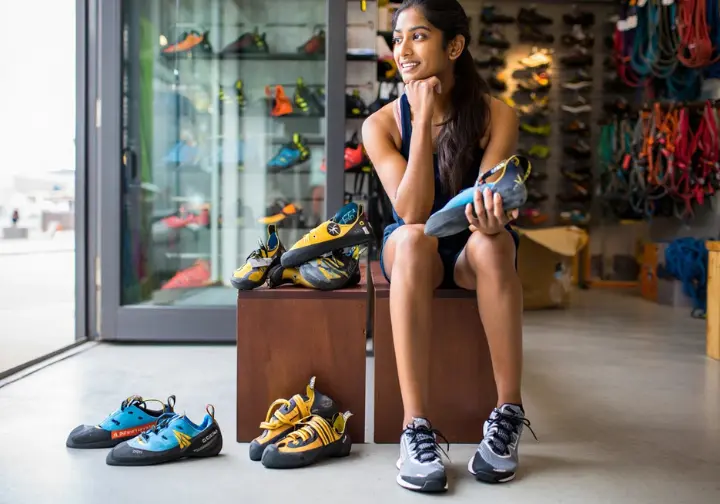
Now that you understand why specialized shoes are critical and what they’re made of, this section guides beginners on selecting their first shoe, focusing on comfort, appropriate features, and avoiding common pitfalls. This is where you transition from searching “rock climbing sneakers” to finding true climbing footwear. What makes the perfect shoe for you will depend on your individual shoe needs.
Priorities: Comfort, Durability, Learning
For new climbers, comfort is paramount; shoes causing significant pain can deter practice and enjoyment. A relatively comfortable shoe allows focus on learning technique. Beginners often have less precise footwork, leading to faster wear on shoe rubber. A shoe with a thicker, more durable sole is generally recommended to last longer during this refinement phase. The first shoe a climber buys should support basic technique development without being overly specialized.
Neutral shoes, with their flatter shoes profile and supportive nature, are typically the best choice for this. Avoid the cheapest shoes (poor quality) and highest-priced shoes or aggressive models (features a beginner can’t use and will find uncomfortable). A well-chosen entry-level climbing shoe balances performance, durability, and cost. While rentals are good for a first try, owning even a basic pair of climbing shoes offers a better, consistent fit and higher quality rubber than typical rental shoes, aiding progression.
The importance of shoe comfort for beginners cannot be overstated. Understanding the difference between rental shoes versus owning your own is also key. Look for information on durability in beginner climbing shoes to make a good investment. When choosing beginner bouldering shoes, specific advice can be very helpful, as is understanding essential indoor climbing gear including shoes.
Sizing: Snug, Not Painful
Climbing shoes must fit more snugly than street shoes to perform, but this shouldn’t mean excruciating pain, cramping, or numbness. The goal is a secure shoe fit eliminating foot movement, without undue suffering. Toes should reach the end of the shoe with no empty space; for a beginner’s first pair, toes can be flat or slightly curved, not painfully scrunched. The heel cup must fit snugly with no air pockets; the shoe heel shouldn’t lift or slip when standing on toes or attempting heel hooks. Width and volume should be close-fitting without significant gaps or pressure points. A foot-specific fit is the aim.
Climbing shoe sizing is NOT standardized across brands or even models within the same brand; relying on street shoe size is unreliable. Always try climbing shoes on, ideally in the late afternoon when feet are slightly swollen. Common beginner mistakes include wearing socks (most climbing shoes are designed for sockless wear for sensitivity) and sizing for street shoe comfort (will be too loose). The myth that shoes must be painful is counterproductive for beginners; pain inhibits learning and enjoyment. Even tight climbing shoes shouldn’t cause agony.
Seeking expert advice on climbing shoe fit from manufacturers or a rock climbing shop is a good idea. Learning how to try on climbing shoes through video reviews can also be beneficial. Understanding common sizing mistakes for climbers, often discussed on platforms like r/climbergirls, can save you from a bad purchase. Knowing how a climbing shoe should fit snugly but not painfully is key, and it’s wise to avoid common sizing mistakes for climbing shoes.
Material and Break-In Period
Unlined leather shoes can stretch significantly (up to a full size), molding to your foot for a custom fit over time, but making initial sizing tricky. Lined leather stretches less, about a half size. Leather is generally breathable but some unlined types can bleed dye. Synthetic shoes stretch minimally, so the initial fit is largely what you’ll have long-term, making sizing more straightforward. Breathability varies; some synthetics have perforated or knit uppers for better airflow. The chosen shoe material impacts this greatly.
Most new shoe purchases require a break-in period. Wear them for short intervals at home initially, then on easy climbs with larger holds. Remove them frequently between climbs at first. Patience is key; break-in can take three to six sessions or more. Leather shoes stretch and mold with warmth and moisture from your feet. Synthetic shoes will soften and become more pliable. Use caution with aggressive break-in methods like wearing shoes in a hot shower (can damage glues) or freezing them with water bags (risks construction damage). The plastic bag trick can help ease tight shoes on initially.
Learning how to break in climbing shoes effectively is crucial. Understanding the differences in climbing shoe materials and having tips for shoe break in period will make the process smoother. Discover how shoe materials affect fit over time or understanding Scarpa shoe materials and break-in for brand-specific insights.
Top-Rated Beginner Rock Climbing Shoes for 2025 (Forget the Sneakers!)

Based on comfort, durability, learning facilitation, and expert reviews, these neutral climbing shoes are excellent choices for beginners. They provide the necessary features to build skills safely and effectively, far surpassing what any “rock climbing sneakers” could offer. This selection represents some of the most worthwhile shoes for those starting their climbing journey.
Best Overall Beginner Shoe
For versatility and proven performance.
La Sportiva Tarantulace | Versatile comfort, great value, molds to foot
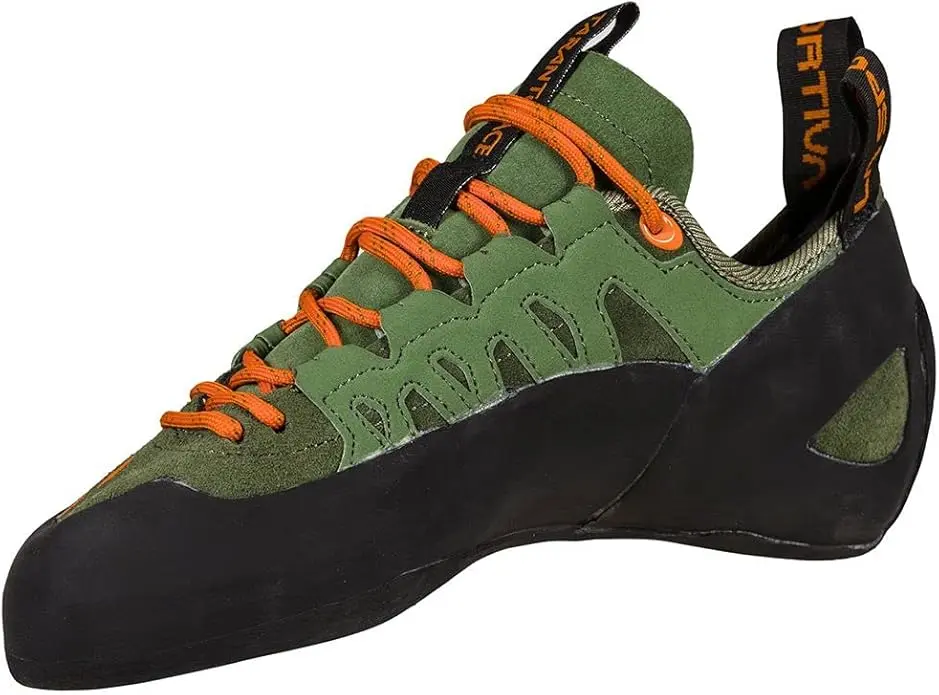
The La Sportiva Tarantulace is a versatile shoe, comfortable climbing shoe, excellent for beginner to intermediate climbers due to its great value and leather upper that molds to the foot. It features an unlined suede leather upper with a synthetic leather overlay for breathability and durability, coupled with a neutral, slightly asymmetric shape and a roomy toe box for comfort. A quick-pull lace closure system and padded double tongue allow for a precise, adjustable fit. The 5mm FriXion RS rubber sole and aggressive heel rand offer sticky grip and durability for edging. This classic shoe is often a favorite climbing shoe for many starting out.
Technical Specifications & Build Quality:
Available in EU sizes 33-46, it offers a neutral fit for regular to narrow feet. The shoe weighs approximately 9.8 oz (278 g) per shoe (size 42 EU). Materials include an unlined suede leather upper, 5mm FriXion RS rubber sole, 1.8mm LaspoFlex midsole, and quick-pull laces. The unlined suede upper stretches significantly (~1-2 weeks break-in), which is great for a custom fit but can lead to overstretching if sized too large initially. The FriXion RS sole is durable, though some rare reports mention peeling with very heavy wear.
PROS
- Versatile for gym, sport climbing, trad, and bouldering.
- Comfortable leather upper that molds to the foot.
- Great value for a beginner to intermediate shoe.
- Sticky FriXion RS rubber provides good grip.
CONS
- Leather upper can stretch significantly, affecting long-term fit.
- Sizing runs small, requiring careful selection and trying on.
- Some users report issues with sole durability or early toe wear with heavy use.
- Lace-up shoes are slower to put on and take off than Velcro.
Recurring feedback praises the Tarantulace for its comfort and versatility, making it a top pick for beginners. Sizing and stretching are common topics, often mitigated by trying on in-store and careful initial sizing.
Performance & Usability:
The quick-pull laces offer a precise fit but take longer than Velcro. The unlined leather and roomy toe box provide all-day comfort after break-in. The sole and upper typically last 6-12 months with regular wear. It’s excellent for V0-V4 grades and 5.4-5.10 routes across various climbing disciplines.
Comparison to Related Products:
Compared to the La Sportiva Tarantula (Velcro version), the Tarantulace offers a more precise, albeit slower, fit. It’s generally lighter and less expensive than the Scarpa Origin but may be less durable. The Black Diamond Momentum is praised for comfort, but the Tarantulace is lighter and molds better to the foot. Some might compare it to the Sportiva Finale climbing shoes for similar beginner-friendly characteristics.
Recommendation:
Choose La Sportiva Tarantulace for versatile, comfortable beginner climbing.
Additional Notes:
The shoe has no specific eco-friendly content noted. It comes with a one-year La Sportiva warranty. For maintenance, clean with a damp cloth and air-dry; replace or resole after 6-12 months of regular wear. Fit tips suggest sizing 0.5-1 size down from street shoes, expecting stretch.
Scarpa Helix | Classic learner’s choice, all-day comfort, Vibram XS Edge grip
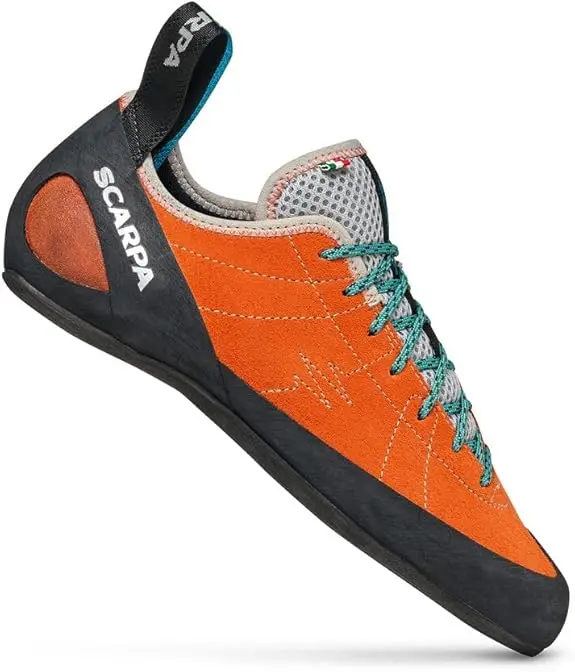
The Scarpa Helix is a classic shoe, a versatile climbing shoe designed for beginner to intermediate climbers, offering all-day comfort and the reliable grip of Vibram XS Edge rubber, ideal for learning footwork. It features an unlined suede leather upper with a flat-lasted, nearly symmetrical profile, and a padded air mesh tongue for breathability. The lace-up design extends to the toe for a precise, glove-like fit. Its Vibram XS Edge 4mm rubber sole and 1.4mm Flexan midsole provide a stiff, durable platform for edging. This shoe is a good example of a unisex climbing shoe that works well for many foot shapes.
Technical Specifications & Build Quality:
Sizes range from EU 35-50, with a women’s-specific narrower last available; downsizing ½-2 sizes from street shoes is recommended. The shoe weighs approximately 7.8 oz (221 g) per shoe (size 39 EU, woman‘s). Materials include an unlined suede leather upper, 4mm Vibram XS Edge rubber sole, and a 1.4mm Flexan midsole. The suede upper stretches about a half size, molding to the foot. The Vibram XS Edge sole excels at edging but may be less sensitive for smearing on advanced routes. The padded tongue is comfortable but may cause blue dye staining initially.
PROS
- Classic shoe choice for beginners and intermediate climbers.
- Offers all-day comfort with its flat profile, suitable for long routes.
- Vibram XS Edge rubber provides excellent grip for edging.
- Precise lace-up fit offers a glove-like feel.
CONS
- Sizing can be inconsistent or run small for some users.
- Blue dye from the tongue may stain feet or socks initially.
- Sole may wear relatively quickly with heavy gym use.
- Less sensitive for smearing techniques compared to softer shoes.
Recurring feedback praises the Helix for its comfort and value, often called “a beginner’s dream”. Sizing inconsistencies are a concern, best addressed by trying on in-store.
Performance & Usability:
The lace-up system provides a precise fit but is slower than Velcro. The flat-lasted, unlined leather offers all-day comfort and stretches for a custom fit, ideal for narrow feet or medium feet. The Vibram XS Edge sole lasts about 6-12 months and is resoleable. It excels for various climbing disciplines up to V0-V4 or 5.4-5.10.
Comparison to Related Products:
The Scarpa Origin is a Velcro alternative; the Helix is lighter and better for edging. Compared to the La Sportiva Tarantulace, the Helix has better grip but is pricier. The Black Diamond Momentum is comfier but heavier, with the Helix offering superior edging.
Recommendation:
Choose Scarpa Helix for comfortable, versatile beginner climbing, especially if edging performance is a priority; a good crack shoe for moderate routes.
Additional Notes:
The Helix has no noted recycled content but is resoleable. It comes with a one-year Scarpa warranty. Clean with a damp cloth and air-dry. For fit, downsize ½-2 sizes from street shoes, expecting about a ½ size stretch.
Best for Gym & Breathability
For those prioritizing airflow and indoor sessions.
Black Diamond Momentum | Exceptional knit breathability, comfortable for gym
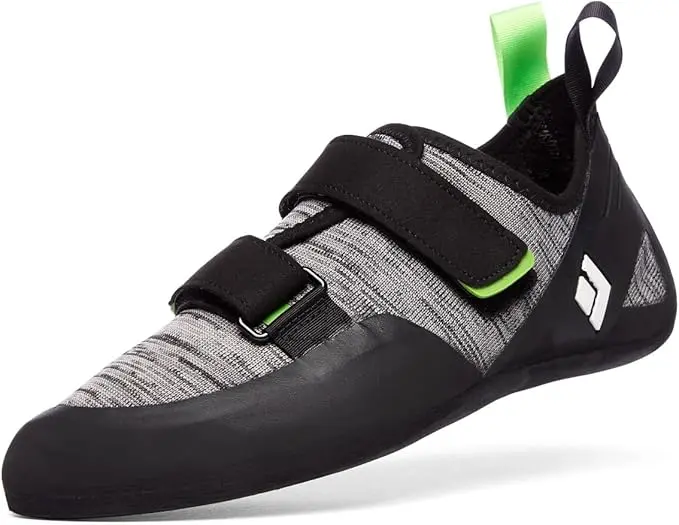
The Black Diamond Momentum is lauded for its exceptional breathability and comfort, making it ideal for beginner to intermediate gym climbers and moderate outdoor climbing. Its Engineered Knit Technology upper provides stretch, support, and airflow, with a microfiber forefoot liner to minimize stretch. It comes in Velcro or Lace versions, with a neutral, flat-lasted shape and soft-flex midsole for all-day comfort. The 4.3mm Black Diamond BlackLabel-Street rubber sole offers consistent grip. This is one of the many shoes that caters well to gym use.
Technical Specifications & Build Quality:
Available in US Men’s 4-13 and Women’s 5-14, it fits regular to wide feet; downsize about a half size from street shoes. It weighs ~10.4 oz (295 g) per shoe (US Men’s 9). The upper is synthetic knit, with a microfiber liner, BlackLabel-Street rubber sole, and soft-flex midsole. The knit upper stretches slightly, and the rubber may wear faster with heavy bouldering on boulders; Velcro can weaken over time. The soft midsole enhances sensitivity but lacks some edging precision.
PROS
- Exceptional knit upper provides excellent breathability.
- Very comfortable shoe for long gym sessions and all-day wear.
- Great entry-level shoe for beginners.
- Reliable BlackLabel-Street rubber offers good grip.
CONS
- Sole can wear quickly with heavy or intensive use.
- The knit upper may stretch slightly over time, loosening the fit.
- Velcro straps (on the Velcro version) can lose their grip with extended use.
- Less precise for micro-edging compared to stiffer shoes.
Recurring feedback highlights comfort and breathability, making it ideal for gym climbing. Sole wear and stretch are common concerns.
Performance & Usability:
Velcro straps or laces provide a quick, secure fit. The knit upper and soft-flex midsole offer all-day comfort, best for regular/wide feet. The rubber lasts ~6-12 months and is resoleable, but heavy bouldering accelerates wear. It’s versatile for gym, bouldering, sport climbing, and moderate trad (V0-V4, 5.4-5.10).
Comparison to Related Products:
The Momentum Velcro is quicker than the Momentum Lace. It’s more breathable but pricier than the La Sportiva Tarantulace. Compared to the Scarpa Helix, it’s comfier but heavier and less suited for precise edging.
Recommendation:
Choose Black Diamond Momentum for breathable, comfortable gym climbing; opt for Momentum Lace for more adjustability.
Additional Notes:
No recycled content is noted, but the knit upper may reduce material use; it is resoleable. It has a one-year Black Diamond warranty. Clean with a damp cloth; resole or replace after 6-12 months. Fit by downsizing ~½ size from street shoes, expecting minimal stretch.
Best for Aspiring Boulderers
Comfort with features for modern bouldering.
Scarpa Origin VS | Bouldering comfort, large toe patch for hooking, sticky rubber

The Scarpa Origin VS is engineered for comfort in modern indoor bouldering and sport climbing, featuring a large M50 rubber-coated toe patch for toe hooking and super-sticky S72 rubber for grip. Its dual-ply microfiber upper and padded air mesh tongue provide breathability and controlled stretch in a neutral, flat-lasted shape. A wide single Velcro shoe closure ensures easy on/off and a secure fit. This shoe is a popular choice for climbers tackling boulders.
Technical Specifications & Build Quality:
Available in EU sizes 35-46, it has a medium-width last; size close to street shoe or ½ size down. It weighs ~8.5 oz (240 g) per shoe (EU 40). The upper is vegan microfiber, with S72 rubber on the sole and M50 rubber for toe/ heel patches. The microfiber offers instant comfort with minimal stretch but might be roomy for narrow feet. The S72 rubber is very sticky but less durable than Vibram XS Edge. The innovative PAF heel system reduces Achilles pressure but can feel soft for aggressive heel hooks.
PROS
- Comfortable for bouldering and gym sessions.
- Large M50 toe patch provides excellent performance for toe hooking.
- Sticky S72 rubber offers great grip for smearing on volumes.
- Easy and quick single Velcro closure system.
CONS
- S72 rubber is less durable and may wear out relatively quickly.
- Can feel too loose or roomy for climbers with narrow feet.
- The heel cup may be too soft for very aggressive heel hooking.
- Some users find the toe box to be narrow or cause pinching for the toes.
Recurring feedback praises its comfort and bouldering performance, particularly the toe patch and sticky rubber. Durability and fit for narrow feet are concerns.
Performance & Usability:
The single Velcro strap allows quick on/off. The microfiber upper and flat last ensure all-day comfort, with the PAF heel reducing pressure. S72 and M50 rubbers grip well but wear faster, lasting ~6-12 months; they are resoleable. It excels for indoor bouldering, sport climbing, and gym climbing (V0-V5, 5.4-5.10).
Comparison to Related Products:
The Scarpa Origin (leather, dual Velcro) is less specialized for hooking than the lighter, stickier Origin VS. The Black Diamond Momentum is more breathable but less adept at hooking and heavier. The La Sportiva Tarantulace is a budget lace-up, while the Origin VS has stickier rubber. Some might compare its hooking ability to more ultra-performance climbing shoes but at a friendlier price.
Recommendation:
Choose Scarpa Origin VS for comfortable, hooking-focused bouldering.
Additional Notes:
The vegan microfiber upper is an eco-conscious choice; it is resoleable. It has a one-year Scarpa warranty. Clean with a damp cloth; resole or replace after 6-12 months. Size close to street shoe or ½ size down, expecting minimal stretch.
Best Value & Consistent Fit
Reliable performance without breaking the bank.
Evolv Defy | Value-packed comfort, minimal stretch synthetic upper
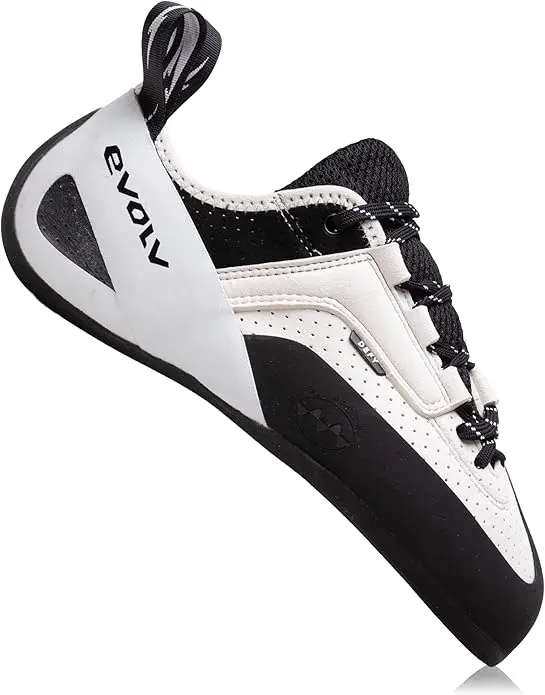
The Evolv Defy offers value-packed comfort with a minimal-stretch synthetic (Synthratek VX vegan microsuede) upper, ideal for beginner to intermediate boulderers and indoor climbers. An Agion antimicrobial nylon mesh lining enhances breathability and odor control within its slightly asymmetric, neutral profile. It features a ¾ speed-lace system or two Velcro straps, and a durable VTR rand. The 4.2mm TRAX SAS rubber outsole (Evolv’s stickiest) and 1.4mm MX-P sensitive shoe midsole provide versatile grip. This shoe is a strong contender for an all-around shoe for new climbers.
Technical Specifications & Build Quality:
Available in US Men’s 4-14 and Women’s 5-15, it has a medium-volume fit; size close to street shoe or ½ size up. It weighs ~8.5 oz (240 g) per shoe (US Men’s 9). The vegan microsuede upper offers minimal stretch for a consistent fit but is less moldable than leather. TRAX SAS rubber is sticky but can wear with poor footwork. The lace system is precise but slower than Velcro; Velcro may weaken over time. Lack of a toe patch limits some hooking.
PROS
- Offers a comfortable, neutral fit suitable for beginners.
- Breathable vegan upper helps keep feet cool.
- Sticky TRAX SAS rubber provides reliable grip.
- Excellent value, being a budget-friendly option.
CONS
- Sizing tends to run small, often requiring sizing up.
- Sole can wear out quickly with heavy or frequent use.
- Lacks a dedicated toe patch, limiting advanced toe hooking.
- Velcro on the strap version may weaken over time.
Recurring feedback praises its comfort and value for beginners. Sizing and sole durability are common concerns, mitigated by trying on and sizing up slightly.
Performance & Usability:
Speed-laces or Velcro offer a secure fit; Velcro is faster but less adjustable. The neutral profile and microsuede upper provide all-day comfort with odor control, best for medium/wide feet. TRAX SAS rubber lasts ~6-12 months and is resoleable but wears with heavy bouldering. It excels for indoor bouldering, gym, sport climbing, and moderate trad (V0-V5, 5.4-5.11).
Comparison to Related Products:
The Defy Lace (PSR 5) is more precise than the quicker Defy Velcro (PSR 4). The Defy LV is a low-volume option. It’s vegan and more breathable than the La Sportiva Tarantulace but less durable. It’s lighter and stickier than the Black Diamond Momentum but less durable.
Recommendation:
Choose Evolv Defy for comfortable, vegan-friendly bouldering/gym climbing at a great price.
Additional Notes:
The vegan microsuede upper is an eco-friendly aspect; it is resoleable. It has a one-year Evolv warranty. Clean with a damp cloth; use baking soda for odor; resole or replace after 6-12 months. Size close to street shoe or ½ size up, expecting minimal stretch.
What About Approach Shoes? The Climber’s “Other” Sneaker
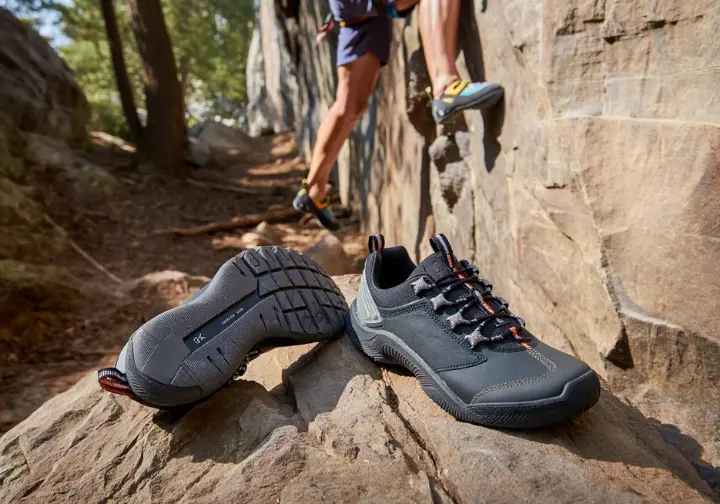
While not for vertical climbing, “approach shoes” are specialized footwear (often resembling rugged sneakers) that climbers use for the hike or scramble to the base of a climb. Understanding their purpose distinguishes them from both climbing shoes and regular sneakers. These are the shoes outdoors enthusiasts might consider for the journey to the wall.
Defining Approach Shoes & Their Use
Approach shoes are a hybrid blending hiking shoe/trail runner features with some climbing shoe characteristics. Their main purpose is for the “approach” – the journey to the crag. Key features include sticky rubber soles (often Vibram Megagrip) for grip on rock, sometimes with a “climbing zone” at the toe for scrambling. Uppers are durable and supportive, more robust than running shoes but more dexterous than hiking boots. Lacing often extends towards the toe for a precise fit during technical scrambling.
They are needed when approaches involve rocky terrain, scrambling, talus fields, or easy fifth-class climbing where hiking boots are too clunky and trail runners lack grip/protection. For beginners at accessible gyms or crags, approach shoes aren’t an initial priority purchase; their utility grows with exploration of more remote outdoor areas. If you’re wondering what are approach shoes used for or about the features of good approach shoes, these are great questions. Deciding when do you need approach shoes often comes down to the terrain you’ll be facing. Considering approach shoes as part of your mountain climbing gear is wise for outdoor adventures, and you might look into selecting approach shoes like the La Sportiva TX4.
Approach Shoes vs. Climbing Shoes vs. Sneakers
Climbing Shoes: Purely for vertical rock climbing; they have an extremely snug fit, specialized sticky rubber, and specific shoe shapes (neutral, moderate, aggressive); unsuitable for walking/hiking. Technical climbing requires this level of specialization. Approach Shoes: Bridge the gap between hiking and climbing for getting to the climb; they balance hiking comfort with scrambling/easy climbing ability; stickier rubber and more precise toe than hikers. Sneakers/Trail Runners: For running/walking on trails/pavement; they prioritize cushioning, general traction, durability, not specialized rock friction; lack stiffness for edging and precision for scrambling. While lightweight trail runners are sometimes used for simple approaches, they fall short on technical terrain.
Hiking Boots: For longer treks, often with heavy packs; prioritize ankle support, protection, durability; generally too clunky, heavy, and lack sensitivity/grip for technical approaches or easy rock climbing. The “climbing zone” on many approach shoes (smoother, stickier rubber at the toe) enhances performance on scrambles and very easy climbs (3rd, 4th, low 5th class). However, it does not make them a substitute for dedicated climbing shoes on technical routes. For further comparisons, consider resources comparing hiking boots and approach shoes or detailing trail running shoe characteristics. It’s also useful to understand the limitations of approach shoe climbing zones. You can learn more about the differences between hiking shoes and approach shoes to make an informed choice.
Top Approach Shoe Recommendations
For dedicated climbers facing technical approaches, these models offer a great blend of hiking comfort and climbing capability.
La Sportiva TX4 Evo | Exceptional durability, support, and comfort for rugged approaches
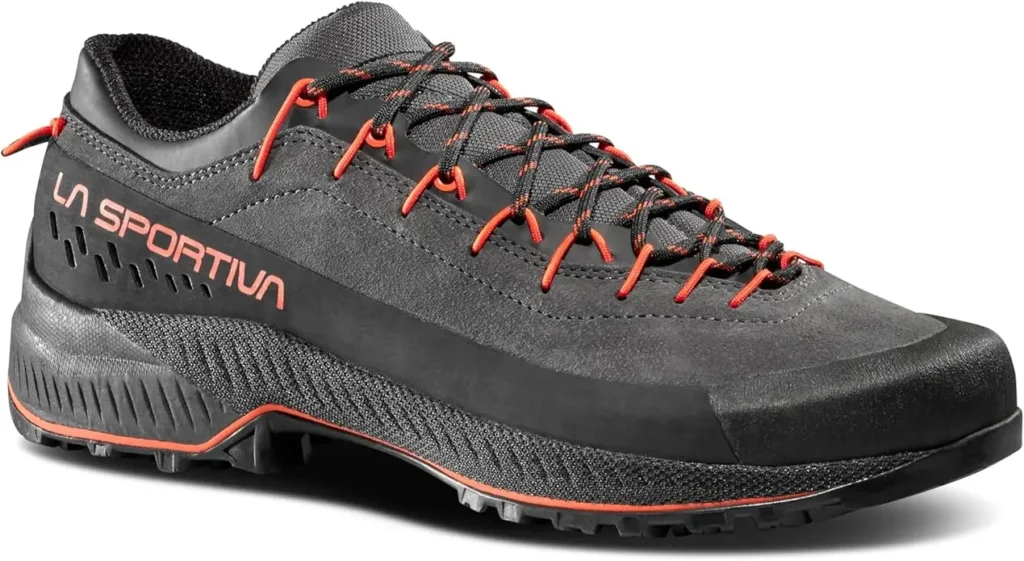
The La Sportiva TX4 Evo is an eco-friendly leather approach shoe built for durability, support, and comfort on rugged terrain, ideal for technical approaches, easy climbs, and hiking. It has nubuck leather uppers, a full rubber rand, and a Resole-Me platform for extended life. The Vibram MegaGrip outsole provides superior grip, and a to-the-toe lacing system ensures a precise fit.
Technical Specifications & Build Quality:
Sizes EU 36-47.5 offer a D-width, wide forefoot fit; size up ½-1 from street shoes. It weighs ~14.2 oz (405 g) per shoe (EU 42). Materials include nubuck leather, Vibram MegaGrip, an EVA midsole, and OrthoLite insole. The leather and rand are durable, but the sole can wear on abrasive surfaces; some find the toe box narrow.
PROS
- Exceptional durability from leather upper and full rubber rand.
- Superior Vibram MegaGrip outsole provides excellent traction.
- Comfortable for hiking with heavy loads and on technical terrain.
- Precise to-the-toe lacing system allows for a dialed-in fit.
CONS
- Toe box can feel narrow for individuals with wider feet.
- Sole may wear more quickly on very abrasive rock or terrain.
- Sizing tends to run small, often requiring users to size up.
- Relatively heavy weight compared to some other approach shoes.
Recurring feedback praises durability and grip, though narrow fit and sole wear are concerns.
Performance & Usability:
To-the-toe lacing offers a precise fit but is slow. Nubuck leather molds to the foot, but the narrow toe box may pinch. Durability is excellent, lasting 6-18 months with heavy wear. It excels for technical approaches, hiking, scrambling, and easy climbing (up to 5.6).
Comparison to Related Products:
The TX2 Evo is lighter but less durable. The TX4 Evo Mid GTX is waterproof but heavier. The TX Guide is more climbing-focused and narrower.
Recommendation:
Choose La Sportiva TX4 Evo for durable, supportive, and comfortable approaches on rugged terrain.
Additional Notes:
It features recycled laces and midsole content and is resoleable. A one-year La Sportiva warranty is included. Clean with leather cleaner; resole or replace after 6-18 months. Fit by sizing up ½-1 size; D-width fits wide forefeet.
La Sportiva TX Guide | Precise climbing performance for technical terrain, excels at smearing/edging
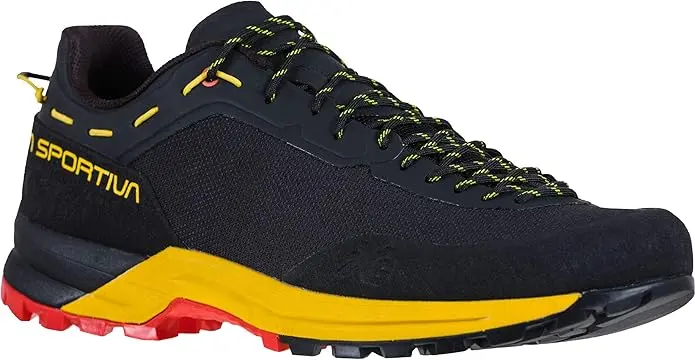
The La Sportiva TX Guide is a high-performance shoe, an approach shoe for precise climbing on technical terrain, excelling at smearing and edging, suited for guides and advanced climbers. It has a dual-density suede leather upper, PU TechLite rand, and a Mythos lacing system for a glove-like fit. The Vibram MegaGrip outsole has a dual-zone climbing design for superior grip. A dual-density EVA midsole with TPU shank enhances torsional rigidity.
Technical Specifications & Build Quality:
Sizes EU 36-47.5 offer a narrow fit, low-volume foot design; size up ½-1 from street shoes. It weighs ~12.7 oz (360 g) per shoe (EU 42). Materials include suede leather, recycled PET lining, Vibram MegaGrip (IdroGrip), and dual-density EVA midsole. The leather upper is durable but less breathable; the sole grips well but can wear on abrasive granite. The narrow toe box and high arch of the foot may be uncomfortable for some.
PROS
- Offers precise climbing performance, especially for smearing and edging.
- Excellent Vibram MegaGrip and IdroGrip outsole provides superior traction.
- Supportive and stable on technical terrain and for moderate climbing.
- Mythos lacing system allows for a highly adjustable, glove-like fit.
CONS
- Narrow toe box and high arch can be uncomfortable for wider or flatter feet.
- Sizing runs small, necessitating careful trying or sizing up.
- Sole can wear relatively quickly on abrasive rock types like granite.
- Leather upper is less breathable than synthetic alternatives.
Recurring feedback praises climbing precision and grip, but narrow fit and sole wear are concerns.
Performance & Usability:
Mythos lacing provides a precise fit but is slow. The leather upper molds to the foot, but the narrow fit may pinch, suiting narrow, low-volume feet. Durability is good for 6-18 months; it’s resoleable but the sole wears on granite. It excels for technical approaches, scrambling, via ferrata, and climbing up to 5.8.
Comparison to Related Products:
The TX4 Evo is more hiking-focused and less climbing-oriented. The TX2 Evo is lighter but less precise and durable. The Scarpa Mescalito is more versatile and wider.
Recommendation:
Choose La Sportiva TX Guide for approaches requiring precise climbing performance on technical terrain.
Additional Notes:
It features recycled PET lining and laces and is resoleable. A one-year La Sportiva warranty is included. Clean with leather cleaner; resole or replace after 6-18 months. Fit by sizing up ½-1 size due to its narrow profile.
Conclusion: Elevate Your Climb with Footwear That Performs
Standard sneakers are fundamentally unsuitable and unsafe for rock climbing due to their lack of grip, support, and precision fit, hindering performance and increasing injury risk. Specialized rock climbing shoes are engineered with sticky rubber, specific lasts, and snug fits to provide the necessary friction, power, and sensitivity for safe and effective climbing. For beginners, choosing a comfortable, durable, neutral climbing shoe is a crucial first investment that directly impacts learning, safety, and enjoyment. Approach shoes serve a distinct purpose for the journey to the climb, offering a balance of hiking comfort and scrambling ability, but are not a substitute for climbing shoes on vertical terrain. Making informed footwear choices from the start, by understanding the difference between “rock climbing sneakers” and true climbing shoes, sets a positive trajectory for skill development and long-term enjoyment of the sport for every climber.
Frequently Asked Questions about Rock Climbing Footwear
Can I really not use my normal sneakers or trainers for rock climbing, even just to try it out? >
How tight should my very first pair of climbing shoes actually feel? Should they be painful like I’ve heard? >
What are the main differences I’ll notice between a beginner (neutral) climbing shoe and a more advanced (aggressive) one? >
Do I need to buy approach shoes right away if I’m just starting to climb at an indoor gym? >
We are a participant in the Amazon Services LLC Associates Program, an affiliate advertising program designed to provide a means for sites to earn advertising fees by advertising and linking to Amazon.com. As an Amazon Associate I earn from qualifying purchases. We also participate in other affiliate programs. The information provided on this website is provided for entertainment purposes only. We make no representations or warranties of any kind, expressed or implied, about the completeness, accuracy, adequacy, legality, usefulness, reliability, suitability, or availability of the information, or about anything else. Any reliance you place on the information is therefore strictly at your own risk. Additional terms are found in the terms of service.



